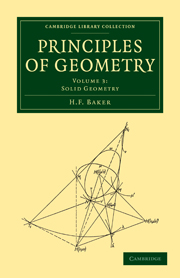Book contents
CHAPTER III - CUBIC CURVES IN SPACE. THE INTERSECTION OF TWO OR MORE QUADRICS
Published online by Cambridge University Press: 05 July 2011
Summary
The curve of intersection of two quadrics. A conic is a curve of which the points are in unique correspondence with the points of a line; it is defined by the intersection of associated rays of two related flat pencils of lines in a plane. In three dimensions there exists a curve, in many ways simpler than a conic, of which the points are also in unique correspondence with the points of a line. Three points of this curve lie on an arbitrary plane, so that the curve is called a cubic. The curve may be defined, analogously to a conic in a plane, by the intersection of associated planes of three related axial pencils of planes. The curve may also be defined as the partial intersection of two quadric surfaces. We have, however, in the theory of confocal quadrics, been led to consider a curve which is the intersection of two quadrics, and is not a cubic. It will therefore add to clearness if, before considering the cubic curve in detail, we enumerate all the possibilities in regard to the intersection of two quadrics; the proof that the list is exhaustive will be given in a later Volume. Since an arbitrary plane meets each of the quadrics in a conic, and two conics in the same plane intersect in four points, the complete intersection of two quadrics must meet an arbitrary plane in four points. This intersection may however consist of several irreducible pieces (curves), of which two may coincide.
- Type
- Chapter
- Information
- Principles of Geometry , pp. 122 - 158Publisher: Cambridge University PressPrint publication year: 2010First published in: 1923



